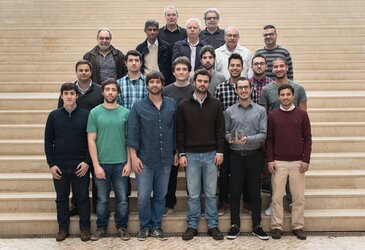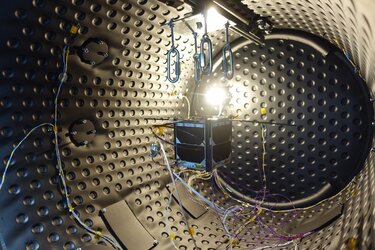Accept all cookies Accept only essential cookies See our Cookie Notice

About ESA
The European Space Agency (ESA) is Europe’s gateway to space. Its mission is to shape the development of Europe’s space capability and ensure that investment in space continues to deliver benefits to the citizens of Europe and the world.
Highlights
ESA - United space in Europe
This is ESA ESA facts Member States & Cooperating States Funding Director General Top management For Member State Delegations European vision European Space Policy ESA & EU Space Councils Responsibility & Sustainability Annual Report Calendar of meetings Corporate newsEstablishments & sites
ESA Headquarters ESA ESTEC ESA ESOC ESA ESRIN ESA EAC ESA ESAC Europe's Spaceport ESA ESEC ESA ECSAT Brussels Office Washington OfficeWorking with ESA
Business with ESA ESA Commercialisation Gateway Law at ESA Careers Cyber resilience at ESA IT at ESA Newsroom Partnerships Merchandising Licence Education Open Space Innovation Platform Integrity and Reporting Administrative Tribunal Health and SafetyMore about ESA
History ESA Historical Archives Exhibitions Publications Art & Culture ESA Merchandise Kids Diversity ESA Brand CentreLatest
Space in Member States
Find out more about space activities in our 23 Member States, and understand how ESA works together with their national agencies, institutions and organisations.
Science & Exploration
Exploring our Solar System and unlocking the secrets of the Universe
Go to topicAstronauts
Missions
Juice Euclid Webb Solar Orbiter BepiColombo Gaia ExoMars Cheops Exoplanet missions More missionsActivities
International Space Station Orion service module Gateway Concordia Caves & Pangaea BenefitsLatest
Space Safety
Protecting life and infrastructure on Earth and in orbit
Go to topicAsteroids
Asteroids and Planetary Defence Asteroid danger explained Flyeye telescope: asteroid detection Hera mission: asteroid deflection Near-Earth Object Coordination CentreSpace junk
About space debris Space debris by the numbers Space Environment Report In space refuelling, refurbishing and removingSafety from space
Clean Space ecodesign Zero Debris Technologies Space for Earth Supporting Sustainable DevelopmentLatest
Applications
Using space to benefit citizens and meet future challenges on Earth
Go to topicObserving the Earth
Observing the Earth Future EO Copernicus Meteorology Space for our climate Satellite missionsCommercialisation
ESA Commercialisation Gateway Open Space Innovation Platform Business Incubation ESA Space SolutionsLatest
Enabling & Support
Making space accessible and developing the technologies for the future
Go to topicBuilding missions
Space Engineering and Technology Test centre Laboratories Concurrent Design Facility Preparing for the future Shaping the Future Discovery and Preparation Advanced Concepts TeamSpace transportation
Space Transportation Ariane Vega Space Rider Future space transportation Boost! Europe's Spaceport Launches from Europe's Spaceport from 2012Latest

Rendering of ISTsat-1
Thank you for liking
You have already liked this page, you can only like it once!
ISTsat-1 is the first-ever nanosatellite designed by students from University of Lisbon’s Instituto Superior Técnico and is part of the second edition of Fly Your Satellite! (FYS), an ESA Education program that gives university students the opportunity to design, build, launch, and operate educational satellites.
Knowing where you are, and where others around you are going is instrumental to safe and efficient transport and even more so in aviation. Aircraft use a system called Automatic Dependent Surveillance Broadcast, abbreviated to ADS-B, to send information at all times to air traffic control.
But as almost three quarters of our planet is ocean there are many blind spots where ADS-B information is not received by ground receivers: enter space-based ADS-B reception.
The University of Lisbon in Portugal has developed the smallest type of CubeSat – a cube just 10 cm wide – that is set to launch on Ariane 6 and will be receiving aircraft ADS-B signals as it orbits overhead at 587 km above our planet. Developed at the university’s Instituto Superior Técnico the satellite is called ISTSat and will weigh just a little over 1 kg using a flat, patch antenna to monitor aircraft for a whole year once launched from the Ariane 6 upper stage.
Although ISTSat-1 will be monitoring aviation, its primary mission is to inspire people in Portugal with a challenging space project. University students from aerospace engineering, electrical engineering, communication networks and computer engineering are working on this project and gaining hands-on experience on how to design, build and manage space missions.
The CubeSat is the fruit of part of ESA’s education ‘Fly Your Satellite!’ programme offering the unique opportunity to be introduced to the working methods adopted in professional space programmes by participating in their own student satellite project.
-
CREDIT
ISTsat-1 team -
LICENCE
ESA Standard Licence

Members of the ISTSat-1 team, including supervising…

Student inspecting ISTSat-1 model before vibration test

Students running ISTSat-1 test at CubeSat Support Facility

ISTSat-1 ready to be baked















 Germany
Germany
 Austria
Austria
 Belgium
Belgium
 Denmark
Denmark
 Spain
Spain
 Estonia
Estonia
 Finland
Finland
 France
France
 Greece
Greece
 Hungary
Hungary
 Ireland
Ireland
 Italy
Italy
 Luxembourg
Luxembourg
 Norway
Norway
 The Netherlands
The Netherlands
 Poland
Poland
 Portugal
Portugal
 Czechia
Czechia
 Romania
Romania
 United Kingdom
United Kingdom
 Slovenia
Slovenia
 Sweden
Sweden
 Switzerland
Switzerland






















